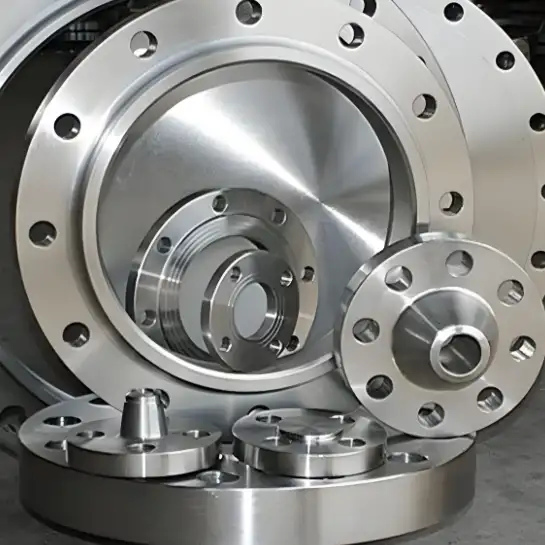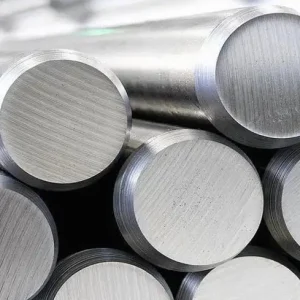Inconel 718 metal stampings are the preferred choice when high strength, corrosion resistance, and stable mechanical performance at elevated temperatures are required in stamped parts — but they demand tailored tooling, process controls, and material handling because of strong work-hardening, high springback, and tool-wear risks. For high-performance applications (aerospace, power generation, oil & gas, and high-end industrial components), Inconel 718 stampings deliver unmatched service life and reliability when produced by experienced suppliers such as MWAlloys, which offers factory-direct pricing from China, ready stock for fast turnaround, and technical support for die design and post-stamp heat treatment.
What is Inconel 718?
Inconel 718 is a precipitation-hardening nickel-chromium superalloy strengthened primarily by niobium (columbium), with additions of molybdenum, titanium and aluminum that form gamma prime and gamma double-prime precipitates during aging. It is produced to established industrial specifications (AMS/ASTM variants) and is widely used for high-strength, corrosion-resistant parts operating from cryogenic temperatures up to several hundred degrees Celsius.
Quick technical snapshot
-
Base: Ni-Cr matrix with Nb (Cb), Mo, Ti, Al.
-
Heat treatment: solution anneal (≈1700–1950°F / 925–1065°C) followed by controlled aging cycles to develop peak strength.
-
Typical service: static and dynamic high-temperature loadings, corrosion exposure, cryogenic toughness.
Why select Inconel 718 for stamped components?
Primary drivers to choose Inconel 718 for stampings:
-
High yield/tensile strength at room and elevated temperatures, making thin stamped sections perform where other alloys would yield or creep.
-
Excellent corrosion and oxidation resistance in many aggressive environments, extending part life.
-
Good weldability and repairability compared with some other nickel superalloys when handled per spec.
-
Dimensional stability after proper heat treatment, important for critical aerospace or power components.
Typical stamped parts: washers, shims, springs, retainers, thin structural brackets, EMI shielding, electron-beam or vacuum components, and micro-parts where high strength and temperature stability are necessary.
Metallurgical behavior that affects stamping
Understanding the alloy’s metallurgy is essential to successful stamping.
-
Strong work-hardening: Inconel 718 hardens with plastic deformation; the surface layers can become extremely tough during forming, increasing required punch force and accelerating tool wear. Processes must manage this tendency.
-
Springback: Elastic recovery is higher than many steels; tight radii and thin features will "spring" back and require die compensation. Experimental studies on sheet forming quantify these springback challenges.
-
Heat sensitivity for strengthening: The alloy develops its final strength by controlled aging (precipitation of γ' / γ''). If parts are formed in the fully heat-treated condition, stamping forces and crack risk increase; therefore many fabricators form in the annealed or solution-treated (soft) condition and then age-harden afterward.
These metallurgical behaviors directly set the processing strategy: select material temper, design dies that allow for springback, use robust tooling, and plan for a post-stamp heat treatment when required.
Manufacturing routes and best practice choices
Material supply forms
Inconel 718 is available as coil/strip, slit coil, sheet, blanks, and foils in various tempers. Choosing the correct form and temper is the first decision: for high volume stampings, slit coil/strip sourced to consistent thickness tolerances gives the best economics.
Cold stamping vs. warm/hot forming
-
Cold stamping (room temperature) is common for thin sections (<1.5 mm, depending on geometry) when the strip is supplied in an annealed condition. Cold forming keeps oxide control easier but pushes tool forces and wear high.
-
Warm forming (elevated but sub-solution temperatures) can ease deformation and reduce work hardening, but requires specialized dies and temperature control. Research into elevated temperature sheet forming reports reduced springback and improved formability in some regimes.
-
Hot forming is less common for thin stampings due to scale, oxidization, and tooling complexity.
Progressive dies & multi-stage forming
For complex parts with small features, progressive dies or transfer presses are recommended to sequence deformation, control burrs, and distribute strain. Proper lubrication and high-quality tool steel are mandatory to avoid scoring and galling.
Tooling and die design recommendations
-
Tool materials: Use high-grade, wear-resistant tool steels (e.g., through-hardened D-series or PM steels) with nitriding or PVD coatings to reduce adhesive wear and galling. Frequent tool polishing and maintenance prolong die life.
-
Punch clearance: Set punch-to-die clearance carefully — Inconel 718 behaves differently from stainless steel; typical clearances may need adjustment from steel defaults to reduce burr formation and punch overload. Pilot trials are essential.
-
Lubrication: Use heavy-duty soluble or semi-synthetic lubricants designed for nickel superalloys; inadequate lubrication dramatically increases tool wear.
-
Progressive forming sequence: Build stages to minimize localized severe strain and to allow intermediate anneals if required. For very thin, high-precision parts, multiple small deformations beat a single severe stroke.
-
Edge preparation and radii: Avoid extremely tight inside radii; larger radii reduce springback stresses and lower crack risk. Design compensation for springback into die geometry based on trial data.
Process control and production parameters
-
Blank temperature and temper control: If the strip is supplied annealed, maintain condition from coil to die (avoid overaging or unintended heating) until after forming if a post-form heat treatment is planned.
-
Press speed and stroke: Lower speeds reduce adiabatic heating and can reduce localized work hardening; however, too slow reduces throughput. Balance speed, feeds, and lubrication to minimize tool heat.
-
Monitoring tool wear: Implement a tool-wear monitoring schedule and spare tool program — die replacement costs can dominate production for Inconel stampings.
-
Trialing and statistical process control (SPC): Run process capability studies (Cp, Cpk) for critical dimensions because springback and burrs can shift distribution over runs.
Post-forming: heat treatment and finishing
Most high-strength applications require the final precipitation hardening (aging) after forming:
-
Solution anneal + age: Industry practice is to solution anneal (≈1700–1950°F / 925–1065°C) and then age under specified cycles (commonly ~1325°F with hold/cool sequences) to reach design mechanical properties. Specific AMS/ASTM specs define the exact cycles.
-
Straightening after heat treatment: Aging can change dimensions slightly (contraction/warpage). Plan final machining, grinding, or straightening after heat treatment when tight flatness is required.
-
Surface finishing: Electropolishing, passivation, or bead blasting can be used depending on finish and fatigue needs. Avoid aggressive mechanical finishing that introduces surface notches.
Quality, inspection and test methods
Critical tests and inspections for Inconel 718 stampings:
-
Mechanical tests: tensile, yield, elongation, and hardness (pre- and post-age) to verify heat treatment.
-
Microstructure: metallography to confirm precipitate distribution and to detect forging/rolling defects if required.
-
Non-destructive testing: dye penetrant for surface cracks on thin parts, eddy current for surface flaws, and X-ray/CT for complicated assemblies if warranted.
-
Dimensional control: coordinate measurement (CMM) and SPC for high-precision parts; account for springback in Cpk studies.
Design recommendations for stamped parts
-
Favor larger radii and avoid extremely thin webs with high localized deformation.
-
Keep feature depth-to-thickness ratios conservative; when deep draws or tall flanges are required consider alternative fabrication (machining, hydroforming, or welded assemblies).
-
For spring applications, consider pre-hardening strategy (form in soft tempers then age) to get final mechanical properties without impossible forming loads.
-
Specify proper tolerances: tighter than ±0.05 mm on thin Inconel stampings often requires extensive scrap and rework — set tolerances consistent with process capability.
-
Discuss post-stamp heat treatment with your supplier at RFQ stage so dies can be designed for final dimensions (account for contraction/warpage).
Typical failure modes and mitigation
-
Cracking during forming: caused by excessive localized strain or poor edge conditions — mitigate by gentler forming steps, larger radii, and intermediate anneals.
-
Galling/adhesive wear on tooling: use coatings, superior lubricants and hard tool steels.
-
Excessive springback: use die compensation, or warm forming to reduce elastic recovery.
-
Burrs and poor edge quality: controlled by punch clearance and sharpness; secondary trimming is sometimes required.
Commercial considerations & MWAlloys offering
Price drivers
-
Raw material nickel prices, alloying element availability, thickness/format (coil vs sheet), and required temper/traceability (certified AMS/ASTM lots) influence per-piece price. High tool wear and slow press cycles push production costs up.
Lead time and MOQ
-
Coil-to-part production is efficient at mid/high volumes. Prototype and low volumes require more setup and often higher unit cost due to die design and more frequent tool maintenance.
MWAlloys capabilities
MWAlloys is a China-based manufacturer specializing in nickel-based superalloy stampings with:
-
Factory-direct pricing: 100% factory ex-works pricing model to reduce middleman margins.
-
In-stock temper options: common strip/sheet tempers stocked for fast sampling and short lead times.
-
Technical support: die design review, trial runs, and post-stamp heat treat coordination.
-
Quality & documentation: full material traceability (mill certs), mechanical testing, and inspection reports per customer requirements.
Contact MWAlloys early in the design cycle to align temper, die design, and final heat treatment to lower risk and cost.
Comparative quick reference table (typical ranges and notes)
| Item | Typical value / note |
|---|---|
| Base composition | Ni balance, Cr ~19–21%, Fe balance, Nb(Cb) ~4.8–5.5%, Mo ~2.8–3.3%, Ti/Al small additions. |
| Service temp (useful) | Up to ~650°C (≈1200–1400°F) for high strength, oxidation resistance higher with coatings. |
| Common tempers for stamping | Annealed / solution treated (soft) for forming; final age hardened after forming. |
| Forming challenges | High work-hardening, springback, tool wear, high forming loads. |
| Best tooling | PM or high-grade D-type steels, nitrided/coated; progressive dies for complex shapes. |
| Typical parts | Washers, shims, springs, EMI shields, brackets (aerospace, power, oil & gas). |
FAQs
-
Can Inconel 718 be cold-stamped like stainless steel?
Yes for many thin parts when material is supplied in the annealed/solution state, but expect higher forming loads and faster tool wear than stainless; progressive forming and heavy lubrication are recommended. -
Should I form Inconel 718 in the fully-aged (hardened) condition?
Generally no. Forming is easier in the annealed/solution condition; final age hardening after forming yields required mechanical properties. Exceptions exist for parts that cannot be heat treated after forming — these require specialist approaches. -
What heat treatment is required after stamping?
A solution anneal followed by a controlled aging cycle (per AMS/ASTM specifications) develops the precipitation hardening that gives the alloy its high strength. Exact cycles depend on the specification called out. -
How do I control springback in Inconel 718 parts?
Use larger bend radii, die compensation based on trial runs, consider warm forming, and rely on progressive multi-stage forming to minimize single large elastic recoveries. -
What surface finishes are achievable on stamped Inconel 718?
Good finishes include fine mechanical finishes, electropolishing, and controlled bead blasting; avoid processes that introduce surface notches detrimental to fatigue. -
How does tool wear compare vs stainless steel?
Tool wear is substantially higher; tool materials, coatings, and lubrication need upgrading relative to common stainless or carbon steels. Expect stricter maintenance intervals. -
Can MWAlloys supply certified material traceability?
Yes, MWAlloys provides mill test reports, heat numbers, and can meet AMS/ASTM documentation requirements on request. -
Is secondary machining needed after stamping?
Often yes for critical features, holes, and finishes. Plan for post-stamp machining after final heat treat if tight mechanical requirements exist. -
What inspection reports do you provide?
Typical packages include dimensional CMM reports, hardness/tensile tests post-age, and visual/dye-penetrant inspections; NDT like eddy current is available for surface crack detection. -
Are there alloy alternatives that are easier to stamp?
Alloys such as Inconel 625 or stainless grades may be easier to form but provide different strength/temperature profiles; evaluate based on the final operating environment.





